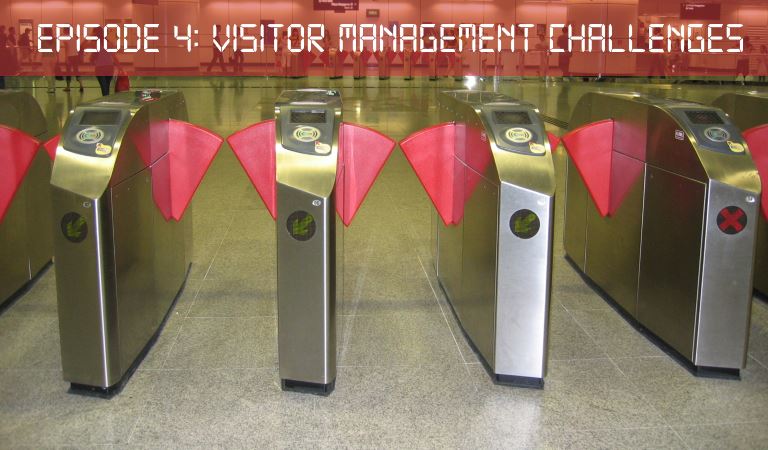Episode 4: Visitor Management Challenges
A visitor came to visit Joe. While Joe was escorting her, he noticed a serious flaw in the visitor check-in process.

A former colleague of Joe, called Janette, contacted Joe for a mutual business opportunity. Having a better-equipped office, Joe invited Janette to visit him at his office. Building security does not allow unauthorized personnel to access any of its facilities, except for visitors who present valid credentials at the security gates. Realizing how difficult it may be for Janette to enter the building, Joe decided to escort her into the building.
Joe was surprised when he saw what the security officer did after holding Janette's ID
Janette arrived. Joe instructed her to present a valid form of identification to the security personnel. Up to this moment, things were going according to Joe's expectations. However, Joe was surprised when he saw what the security officer did after holding Janette's ID. He opened a drawer full of IDs of other visitors, found an available visitor badge, replaced the slot where the badge is kept with Janette's ID and passed the visitor badge to Janette. Joe was curious about this fundamental flaw in the visitor check-in process.
After a successful business visit, Janette left Joe's office. Joe helped her check out. He noticed that all the security personnel had to do was find the slot where the visitor badge should be stored, replaced Janette's ID with the visitor card and then handed Janette's ID back to her, thanking her for the visit.
Visitor Management Challenges
Time vs. Data
The security office is not keeping track of a visitor's details in any form
The security office is not keeping track of a visitor's details in any form. Joe asked the security personnel for the reasons. Joe found that it was a race between time and data. It would usually take a security officer 1-2 minutes to log the details of a visitor in a log book. The office had initially opted to use pencil and paper for logging and found that it was a time-consuming process. Visitors would not have this much patience during the check-in and if they would come into the company in large numbers, this process would pile them up in front of the security desk, hurting the overall business of the organization. When opting to use computers, it would take the security personnel even a longer period of time. Security office had taken a conscious decision to trade data accuracy for efficient time.
Credentials are not verified
The security personnel had no time to verify the validity of Janette's ID
The security personnel had no time to verify the validity of Janette's ID. In fact, the security officer didn't even notice that Janette's photo in the ID was a very old one. Janette presented her Driver's License as the form of ID. Since there was no standard list of acceptable forms of identification, security personnel had to settle for anything handed to them by a visitor.
Visitor correlation impossible
The same visitor badge number can be used by more than one visitor during any day
Joe realized that this would cause the organization a lot of issues in case a security incident occurred. The same visitor badge number can be used by more than one visitor during any day. Hence, it was not possible to correlate a visitor badge with any visit. In case of a security incident, there is no way the organization can determine who was the visitor involved in the incident.
In the absence of accurate visitor data, the organization's security was in jeopardy.
Solution - SharperVisitorLogs
Time and data accuracy friends, not foes
Joe stormed into Jane's office and raised his concerns over the security of the organization. Jane was not aware of this extremely serious issue. She agreed that they should find a solution to this problem.
A solution should capture the details of a visitor as accurately and quickly as possible
After some research, Joe found that a viable solution should establish peace between time and data accuracy. The solution should provide ways to capture the details of a visitor as accurately as possible, while making sure that this happens at the shortest possible period of time. Instead of having to optimize a visitor's waiting time at the expense of data accuracy, the solution should not force the organization to choose between the two options. The organization should have both options together.
A solution should notify the security personnel that the identification is not valid
The organization shall provide a list of acceptable forms of identification. Only when a visitor presents an acceptable form of identification shall s/he be allowed access to the organization's facilities. Based on the expiry date of the presented credentials, the solution should notify the security personnel that the identification is not valid in case it had expired or does not meet the specifications. This would save the organization's reputation, time and money.
Association & correlation
A solution should provide means to correlate a visitor to a specific visit
A viable solution should also provide means to correlate a visitor to a specific visit. The solution should automatically check the visitor in at the moment the credentials are captured. The visitor's tenant should also be kept in the system. This would allow the correlation of a visitor to the badge used, as well as the tenant the visitor went to.
When a visitor checks-out, the solution should make it possible to quickly check the visitor's record out at the time of the checkout, making it very easy for the security personnel and the visitors. Using extensible reports, the solution should make visitor details available to the security personnel as and when a security incident occurred.